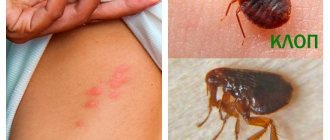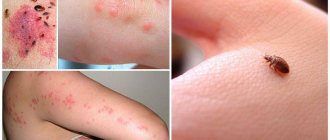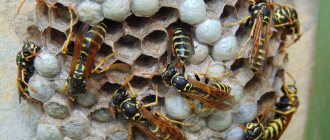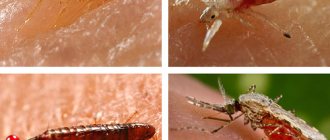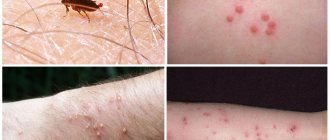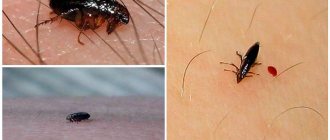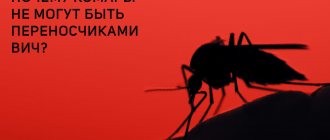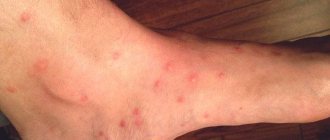Fleas are believed to live on animals. And that's true. One species prefers to live on dogs, another on cats, a third on rats, etc. Accordingly, they are classified as canine, feline, or rat. But there is also a human one.
This, however, does not mean that the rat flea bites only rats, the dog flea only bites dogs, and the human flea only bites people. Insects bite all organisms where they can profit from blood. Their bites can be very dangerous.
What is a flea?
The human species prefers to be in the company of people, but does not live directly on the person himself. She uses it as a power source and means of transportation. But it can parasitize pets.
The exception to this rule is the penetrating or Brazilian ground flea. Fertilized females are able to invade the human body, mainly under the big toe nail. However, this species lives exclusively in tropical latitudes and is not found in Russia.
The flea is a small, blood-sucking, brown parasite. Body size is small. Maximum length three millimeters. It has incredible jumping ability. Can jump to a height of 30 centimeters and 50 centimeters in height.
In appearance it is practically no different from other species. The difference in body structure can only be determined by an entomologist, and even then under a microscope. There are also no differences in habits and damage caused.
If fleas have settled in a human home, they lay eggs in secluded places (floor crevices, basements, attics, etc.). After a certain time, the larvae hatch, which turn into pupae, and from them adults (imagoes) are obtained, which attack humans and animals.
They cannot live without blood. They need it not only to ensure their existence. When hungry, they lose the ability to mate and reproduce. Without blood, they do not reach sexual maturity. The imagoes drink more blood than they can digest. But not because of bloodthirstiness. In this way they take care of future offspring. Undigested blood is expelled as feces. They are necessary for the larvae, which feed on them until they become pupae.
Females consume more blood than males. They need this in order to lay eggs safely.
Prevention
Preventive measures against flea bites are aimed at preventing the appearance of insects in a person’s home, and include:
- regular cleaning of the premises, including in hard-to-reach places;
- if insects have already appeared in the house before, you should carefully seal the existing cracks (in windows, walls, under baseboards), and lay out dried plants that repel fleas (tansy, mint, wormwood);
- carefully check the fur of pets for the presence of parasites;
- purchase special flea collars and other means of protection against parasites for animals;
- carry out timely cleaning of bedding and rugs for animals;
- wash animals' paws after walking outside;
- Once a month, carry out general cleaning with a soda-soap solution, which repels insects.
If trouble cannot be avoided, you should call the sanitary-epidemiological service or another pest control service to professionally eliminate the problem.
How do they bite?
The oral apparatus is an effective piercing-sucking instrument. The duration of the bite can last from several seconds to several tens of minutes.
After the flea is on the victim's body, it begins to determine the location for the bite. Then a test puncture of the skin is performed in search of a blood vessel. If it enters the vessel the first time, it immediately begins to feed, secreting saliva, which contains anticoagulants so that the blood does not clot. When the first attempt fails, the attempt is repeated, and so on. Therefore, three or four bites located nearby are observed on the skin. Sometimes she is forced to move because the owner begins to move and itch during the bite.
It bites quite painfully. Their saliva does not contain an anesthetic. People describe the pain of a bite as being similar to the pain of an unexpected prick.
Animals react violently to a bite. Many people have probably watched the picture when a dog, lazily dozing, jumps up as if stung and begins, chattering its teeth, catching something in the fur or scratching itself furiously.
Since their habitat is gender, they bite people in the area of the lower extremities (feet, legs). Other places at risk of being bitten are when a person is sitting on the floor. On the face, flea bites are registered sharply. In this regard, a small child is more at risk.
Can clothing help prevent bites? Not always. Rough, thick fabric, such as denim, will prevent a flea from biting. It is impossible to bite on those parts of the body where clothing does not fit tightly to the body. But fleas can bite through thin tight fabrics (tights, fitness tights, etc.). It should be borne in mind that fleas can hide for some time (up to a day) in the folds and seams of clothing, periodically crawling out to find a naked area of the body.
What do the bites look like?
Insects pierce the skin without leaving visible damage. There is either very little bleeding at the bitten area or none at all. In those places where the parasite did not enter the vessel, tiny red dots remain, which disappear on their own after three days.
Itching appears immediately after the bite.
When a vessel is damaged, a different skin reaction is observed. After a certain period (five to thirty minutes), the affected area turns red and swells. The size of the red spot can range from two millimeters in diameter to ten. The speed at which spots appear and their size depend on the individual characteristics of the organism.
In addition to immediate reactions, there may be skin reactions delayed over time (papules, vesicles).
Possible complications
A flea bite on a person, whose photo most often shows small red spots or blisters, is rarely taken seriously.
However, such minor rashes can cause the development of serious pathologies and lead to:
- tachycardia;
- partial damage to the nervous system;
- prolonged heart pain and low blood pressure;
- attacks of suffocation and panic attacks;
- swelling of the trachea, larynx;
- Quincke's edema;
- anaphylactic shock;
- lethal outcome.
In addition, parasite bites can change the psycho-emotional state - a person becomes nervous and irritable, constantly itches, and in places of imaginary bites false pain sensations occur, not accompanied by the redness characteristic of bites. As a rule, this condition goes away when the parasites are completely eliminated.
Flea bites on humans are an unpleasant and quite painful phenomenon, not only from an aesthetic aspect (as evidenced by numerous photographs of the consequences of flea attacks), but also from a medical point of view, since these insects are carriers of serious (and sometimes fatal) diseases for humans.
Parasites can appear unexpectedly even in a perfectly clean apartment without pets, so you should not neglect preventive measures, and when cleaning, sometimes replace ordinary water with a solution of soap and soda.
Author: Anna Lalochkina
What else are dangerous?
If a person is prone to allergies, severe swelling and even anaphylactic shock are possible.
Itching causes an irresistible desire to scratch. Intensive scratching runs the risk of causing a bacterial infection with the formation of ulcers.
They can be carriers of a number of dangerous diseases. These include:
- plague,
- salmonellosis,
- helminthiasis,
- hepatitis B and C,
- tularemia, etc.
However, this does not mean that every person bitten will necessarily develop one of the listed diseases.
Transmitted diseases
A flea bite on a person, a photo of which clearly shows the visible consequences of an insect attack, is dangerous not only for its external signs and discomfort.
Fleas are carriers of various diseases, including those fatal to humans. Thus, rat fleas are considered one of the reasons for the spread of plague epidemics that destroyed medieval settlements and entire cities.
| Types of diseases | Classification | Incubation period, days | Carriers of the pathogen | Brief description, symptoms |
| Diseases of the musculoskeletal system | Brucellosis | 7 – 14 | Cattle and small cattle, pigs. | Characterized by joint pain, weakness, sweating and sudden increases in body temperature. Over time, the disease spreads to other organs, covering the nervous, respiratory, cardiovascular, digestive and genitourinary systems. |
| Diseases of the nervous and cardiovascular systems | Typhus | 6 – 14 | Small rodents. | Severe headaches, confusion, pink rash, fever, chills, back pain, high temperature. Possible death. |
| Encephalitis | 4 – 21 | Livestock, small rodents, birds. | The virus infects nerve cells, spreading to the brain. May be accompanied by nausea, vomiting, headaches, fever, convulsions, impaired consciousness, loss of sensation in the limbs, and hallucinations. | |
| Listeriosis | 7 – 30 | Pets. | Weakness, fever, inflammation of the lymph nodes, headaches, conjunctivitis, sore throat, rash. The disease can take the form of encephalitis, meningitis. Possible death. | |
| Skin diseases | anthrax | 2 – 4 | Livestock. | The formation of a carbuncle (most often a single one) followed by ulceration and the appearance of a scab, accompanied by an increase in body temperature, fever, weakness, itching and swelling. In the intestinal or pulmonary form, death is possible. |
| Tularemia | From a few hours to 21 days | Small rodents, hares, rabbits. | The infection affects the skin, lymph nodes, sometimes affecting the mucous membranes. Accompanied by headaches, fever, muscle aches, swollen lymph nodes, sweating, and pinpoint lesions of the mucous membranes. | |
| Bubonic plague | 2 – 12 | Small rodents, wild and domestic animals. | It is characterized by the presence of a specific bubo (pronounced skin neoplasm, most often in the groin), fever, high temperature, pain in the groin area, and weakness. | |
| Diseases of the gastrointestinal tract | Pseudotuberculosis | 3 – 21 | Small rodents. | It affects the intestines, spreading to the liver, and sometimes affects the joints. The disease is characterized by fever, abdominal pain, diarrhea, vomiting, headaches, conjunctivitis, and a white coating on the tongue. |
| Salmonellosis | From 6 hours to 2 days | Wild and domestic animals, humans. | Acute intestinal infection, accompanied by symptoms: vomiting, weakness, diarrhea, abdominal pain, fever, dehydration. |
A flea bite on a person can transmit bubonic plague!
Any infectious diseases transmitted by blood-sucking parasites are called vector-borne diseases. Infection can enter the human body not only through the saliva of an insect, but also when scratching an existing bite wound.
However, flea bites can lead not only to infection by a virus or bacteria, but also cause the body to respond to saliva containing substances that prevent the victim’s blood from clotting.
They can cause an allergic reaction and contribute to the development of dermatitis, eczema, urticaria, and Quincke's edema. Children and people prone to allergies are especially susceptible to this phenomenon.
How to distinguish from bedbug bites
In their hunting style, fleas resemble bed bugs. They drink blood and hide in a secluded place. Their bites can be confused because they are similar in appearance. However, there are also differences.
Bedbugs come out to hunt mainly at night. During the day they attack extremely rarely, and only when the bug is very hungry. Fleas attack at any time of the day.
Bedbugs prefer not to attack animals, as it is difficult for them to reach the skin through the fur and undercoat. Fleas, on the contrary, like animals as objects of attack.
When bedbugs bite a person, they inject an anesthetic substance into the wound, which is why most people do not feel the bites.
Bed bugs usually bite the upper body, neck, and arms. The “working” zone of fleas is located mainly below the knees.
As bedbugs feed, they leave a trail of bites behind them.
Their presence can be guessed by brown spots on the bed linen. A person, tossing and turning in his sleep, accidentally crushes them.
Methods of disposal
Now you know what parasites look like, all that remains is to find out how to fight them. The destruction of insects is a responsible matter that does not require delay.
To remove fleas, you should use a whole arsenal of means. First of all, you should use a vacuum cleaner to vacuum all fluffy and fabric surfaces in the apartment. Parasites lay eggs in them. After treatment, it is necessary to disinfect the vacuum cleaner, otherwise insects will constantly get out of it.
Finding out that there are fleas in your bed is not easy. Parasites are difficult to distinguish even on the palm of your hand
To further combat fleas, you will need simple tools:
- rags;
- mop;
- water;
- bucket;
- disinfectants.
Don’t forget to stock up on personal protective equipment – rubber gloves, a respirator. Dichlorvos can act as a disinfectant.
The consumption of many aerosols is 1 bottle per 10 m2, so you should calculate the required amount of product in advance. Store-bought drugs are the most effective, but they will cost more. The following are popular means of this type:
- "Chlorpyrimark";
- "Biorin";
- "Effective Ultra";
- "Sinuzan."
First of all, you should use a vacuum cleaner to vacuum all fluffy and fabric surfaces in the apartment.
Before carrying out flea treatment, several preventive measures should be taken:
- Carry out wet cleaning of the room.
- Close the aquarium and turn off the compressor.
- Put flea collars on animals.
2 hours after disinfection, the room must be ventilated, and cleaning will not be possible for another 2 days.
You can also learn how to identify and remove fleas from your carpet.
How to treat?
You should try not to scratch the damaged area of skin, although this is not easy to do because of the severe itching, especially for children. First of all, you need to wash the wound with soap and water. If you don't have soap on hand, you can use just water. Ice is then applied to prevent swelling.
Medications
You can disinfect the wound with any antiseptic (alcohol, chlorhexidine solution, etc.) To cure swelling and itching, creams, gels and ointments are used (Fenistil, Flucinar, etc.). They need to be smeared with a thin layer and gently rubbed into the skin.
If you are prone to allergies, you need to take an antihistamine tablet (Suprastin, Claritin, Diphenhydramine, etc.).
If severe swelling is observed, especially against the background of elevated temperature, you should immediately consult a doctor.
Folk remedies
Traditional treatment recipes also help to get rid of the unpleasant consequences of a bite. There are quite a lot of them. You can dilute apple cider vinegar with water in a two to one ratio, moisten a cotton swab or swab and apply it to the wound. Regular baking soda works well. To obtain a solution of the required concentration, you need to stir a teaspoon of soda in a glass of boiled water. Aloe leaves are used. The leaf is washed and the skin is cut off. The pulp of the leaf is applied to the desired location.
